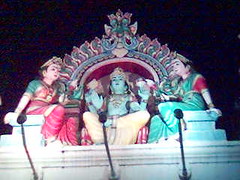Mariamman Temple

Statues
Originally uploaded by katongking.
Sri Mariamman Temple is the oldest and most important of Singapore's Hindu religious buildings. It is dedicated to the goddess Mariamman who is known for her power in curing epidemic illness and diseases. Located in the heart of Chinatown, its ornamental entrance tower or gopuram, has been a landmark to generations of Hindu worshippers and Singapore residents alike. The temple has even given names to the streets flanking it: Temple and Pagoda; to the Chinese, Pagoda Street is known as "Back of the Indian Place of Worship".
Sri Mariamman Temple was established by Naraina Pillai, a government clerk in Penang who accompanied Raffles on his second visit to Singapore in mid-1819. Pillai rapidly established himself in business and became a community leader. He was a building contractor, set up the first brick kiln on the island and founded a shop selling cotton piece goods in Cross Street. In 1822, he was appointed Chief of Indians from Cholamandalam and given the power to settle disputes among the Tamil-speaking population of Singapore.
The English East India Company's original allotment of land for a Hindu Temple was in Telok Ayer Street. However, as it had no convenient source of fresh water needed for rituals, the resident, Colonel William Farquhar, allowed Pillai to occupy an alternative plot near what is today's Stamford Canal in 1821. The South Bridge site was finally granted in 1823.
By 1827 there stood a temple of wood and attap structure at the present site. The small deity installed by Naraina Pillai still has its divinity in the main sanctum, referred to as the "Sinna Amman".
In 1843, a building, using plaster and brick was put up for the first time. In 1963, a new brick building was built. Indian craftsmen were also brought in to undertake sculptural works. The first gopuram (main tower gateway) was constructed in the late 1800's. It did not contain mush sculptural or ornamental works at that time. A covered walkway, connecting the sanctums to the gopuram was built in 1916. After the temple gopuram was built was built in 1863, records do not show of any kumbabishegam (consecration) ceremony being conducted until 29 June 1936. The next kumbabishegam was 12 years later on 1 June 1949, 6th Jun 1971, 6th Sep 1984 & 19 May 96.

<< Home